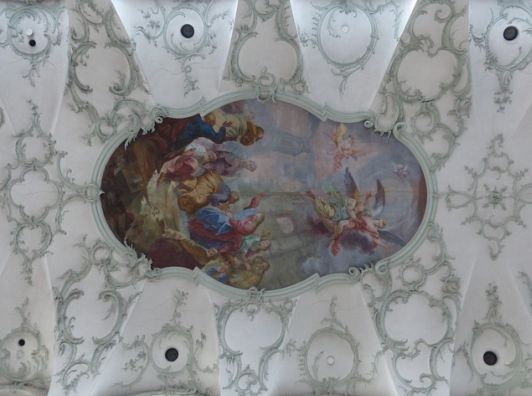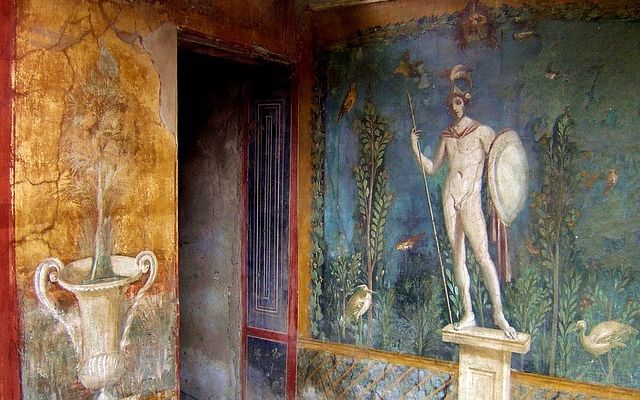Roman Painting – Exponents and Characteristics
Contents
What is Roman Painting?
The history of Roman painting is essentially a history of wall paintings on plaster. Although there are ancient literary references reporting Roman paintings on wood, ivory, and other materials, it is the works that have been executed in the durable medium of fresco that have survived, as it was used to decorate the interiors of private homes in Roman cities and the countryside. According to Pliny, it was Studius who first instituted this technique of painting on walls, with depictions of villas, porticoes and gardens, landscapes, forests, groves, hills, pools, canals, rivers and coasts.
Despite the lack of physical evidence, it can be assumed that many portable paintings depicted themes similar to those found on the painted walls of Roman villas. It is also reasonable to assume that Roman panel paintings, which included original creations and adaptations of famous Hellenistic works, were the prototypes for the myths depicted in fresco. Thus, Roman artists specializing in fresco probably traveled with notebooks to reproduce the traditional paintings as well as the decorative patterns of the Greeks.
Roman painting is defined by the majority of Roman frescoes in Campania, a region around the Bay of Naples. It is here in this region that Mount Vesuvius erupted in 79 A.D., burying much of the countryside, the cities of Pompeii and Herculaneum, as well as private residences. As so often happens in archaeology, a disaster serves to freeze a moment in the past, allowing excavations to delve deeper into the lives of the region’s ancient inhabitants. The frescoes in the villas of Boscoreale and Boscotrecase provided an unprecedented record of the life of wealthy Romans during this period.
How did Roman painting develop?
Archaeologists and art historians describe the development of Roman painting in four styles. The first style (200-60 B.C.) was largely an exploration of simulated marble of various colors and types of painted plaster. Later, artists of the late Republican period (after the first century B.C.) drew on examples of Hellenistic painting (256th century B.C.) and the principles of architecture in order to simulate masonry. Generally, the wall was divided into three horizontal, painted zones, crowned with a stucco cornice of dentils according to the Doric architectural order. The decline of this style coincided with the Roman colonization of Pompeii in 80 B.C., which transformed what had been essentially an Italic village with Greek influences into a Roman city. It goes beyond the simple depiction of expensive building materials, as artists began to borrow the figurative repertoire of Hellenistic wall painting, depicting gods, mortals and heroes in different contexts.
The second style in Roman wall painting emerged in the first stage, from the first century B.C., during which fresco artists imitated architectural forms purely by pictorial means. Instead of stucco architectural details, they used flat plaster in projection and in recession were suggested by shading and perspective. As the style progressed, they became more complex. The Villa Fannius Synistor at Boscoreale is an exceptional example of the second style fully achieved. Thus, throughout the villa there are visual ambiguities in view, painted walls, pillars and columns that cast shadows in the viewer’s space and more conventional devices of the truncated eye technique (trompe de l’oie). Likewise, everyday objects are represented in a way that seems real, as in the case of metal and glass vases on shelves and tables that appear projected off the wall. At Boscoreale, the walls dissolve into elaborate displays of illusionistic architecture and fantasy realms.
Some of the frescoes provide copies of the lost, but probably once famous paintings of the Hellenists. In the villa’s triclinium, a series of figurative paintings of column frames were found presented as if through a window in the wall or as if it were architecture. The owner’s intention was to create a gallery of sorts, with the choice of subjects probably based on the quality and renown of the original paintings.
Under Emperor Augustus (27 B.C. to 14 A.D.) in the second half of the first century B.C., there was a new impulse to innovate, rather than re-create, in architecture, sculpture and painting. This third style (20 B.C. to 20 A.D.), which coincided with the reign of Augustus, rejected illusion in favor of superficial ornamentation. Thus, the wall paintings of this period typically comprise a monochrome background, red, black or white, with architectural and vegetal details. Thus, scenes are presented in which figures and landscape appear in the center of the wall, being part of, not being the dominant element in the overall decorative scheme. The best known achievements of this third style are the frescoes of the Imperial villa at Boscotrecase, where the attenuated candelabra are evident, and the supporting columns exquisitely presented in vignettes. The third style was indeed the style of the court of Emperor Augustus and Agrippa, which eventually gave way to a revived interest in elaboration and innovation.
In the same vein, characterized as a reaction to the mannerism of the third Baroque style, the fourth style of Roman mural painting (ca. 20-79) is generally less disciplined than its predecessor. It revives large-scale narrative painting and panoramic views, while retaining the architectural details of the third style. In this Julio-Claudian phase (20-54), a textile-like quality dominates and filaments seem to connect all the elements on the wall. Once again, warm colors are used to advantage in the depiction of scenes from mythology.
Thus, some of the best examples of Roman mural painting techniques is Pliny’s Natural History and Vitruvius’ manual of Architectura, who describes the methods elaborated by mural painters, including the insertion of lead sheets in the wall to prevent capillary action of moisture from attacking the fresco, the preparation of up to seven layers of plaster on the wall and the use of marble dust in the upper layers to produce a mirror-like sheen on the surface.
What is the importance of Roman Painting?
Roman artists created their masterpieces with homemade pigments. The pigments were made according to ancient Greek formulas. These artists used several different ingredients to achieve the desired colors, including burnt apple seeds, pulverized semi-precious stones such as lapis lazuli, charcoal, animal and human bones, natural rock pigments such as celadonite and chlorite, pomegranate juice and even ibulian beetles. Each artist mixed their own batch to use as needed. Similarly, they used egg tempera which was a radiant, semi-transparent paint that dried almost immediately.
In the same vein, the artists painted on portable panels and directly on the plaster (fresco) walls of their rooms. For the interiors of the rooms, the Romans were passionate about the effects of the truncated eye technique, mythological and erotic scenes. Likewise, frescoes were discovered under volcanic ashes 2,000 years ago in Pompeii from which were rescued illustrations in the bedrooms animated with multiple activities in multiple couples. It is believed that many of the pigments were extremely toxic as they caused festering wounds that never healed, bald patches, affected lungs and within a few years death. Thus, former slaves were generally employed to grind the pigments and binders of the mixtures. Thus, classical Roman paintings survived mainly in the cities that were buried under the volcanic ash of Vesuvius, thus preserving the art.
What is the legacy of Roman painting?
Art was a very important part of Roman life. Most of the decoration of their homes, their businesses and their temples was with paintings and large murals made of small pieces called stone mosaics. Roman art left an enduring legacy. Both Roman painting and sculpture and architecture was very influenced by ancient Greece and was very realistic, seeking to make life as faithful as possible to its reality. Therefore, most temples and important government buildings were covered in reliefs, marble panels with deeply carved backgrounds for whose figures stand out in almost three dimensions. A series of these panels together told stories and depicted scenes from Roman history and mythology. Therefore, Roman style reliefs were very influential throughout history in Christianity. Therefore, reliefs with scenes from the Bible decorate many of the most important and influential cathedrals in the world today.
Who are the most important painters of Roman Art?
Below are some of the most renowned Roman painters due to the quality of their works:
-Publius Aelius Fortunatus was a Roman painter who lived in the 2nd century BC. This painter became popular due to one of his works called: libertus.
-Arellius was the celebrity Roman painter in the 1st century BC, shortly before Emperor Augustus. Arellius was very popular in Rome and was distinguished by his passion for women that he always depicted in his paintings, with the likeness of prostitutes. This painter was mentioned by Pliny, a Roman philosopher in his book Natural History.
-Gaius Fabius was one of the first Roman painters whose paintings have survived. Gaius was recognized as a painter after his paintings of the temple of Salus. His paintings were preserved until the reign of Emperor Cius. However, a fire destroyed the temple and all his paintings disappeared with it. Before this painter there was no tradition of painting existing in Rome.
-Malibu was a Roman painter popularly known for his portrait painting of the Fayum mummy. Mostly known for the highlighting of shadow in his paintings. Malibu’s paintings contain a distinctive shape of the nose and mouth. His portrait of the Fayum mummy was painted directly on the rags of the mummy’s wrappings.
-Spurius Tadius Fabulous landscape mural painter during the reign of Augustus, Tadius was praised for his villas and harbors. There were alternate names of him as Studius Ludius in some manuscripts.


